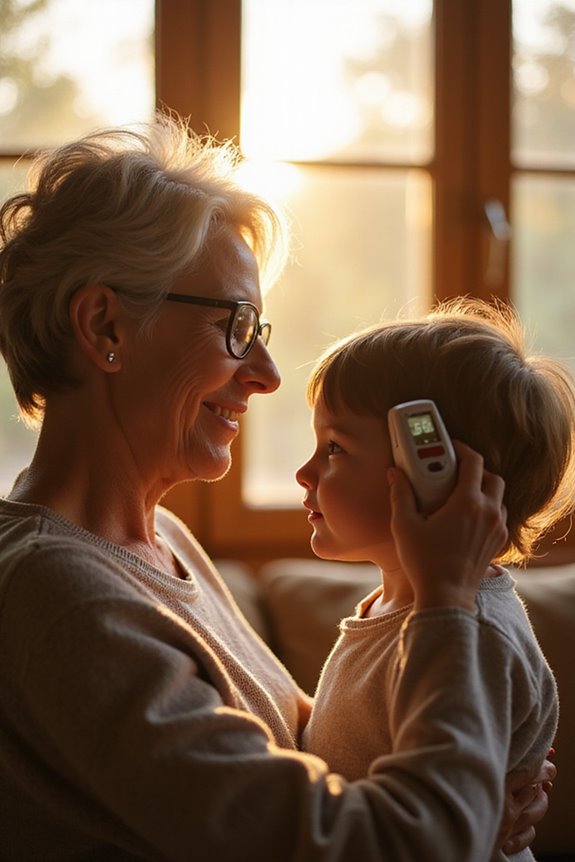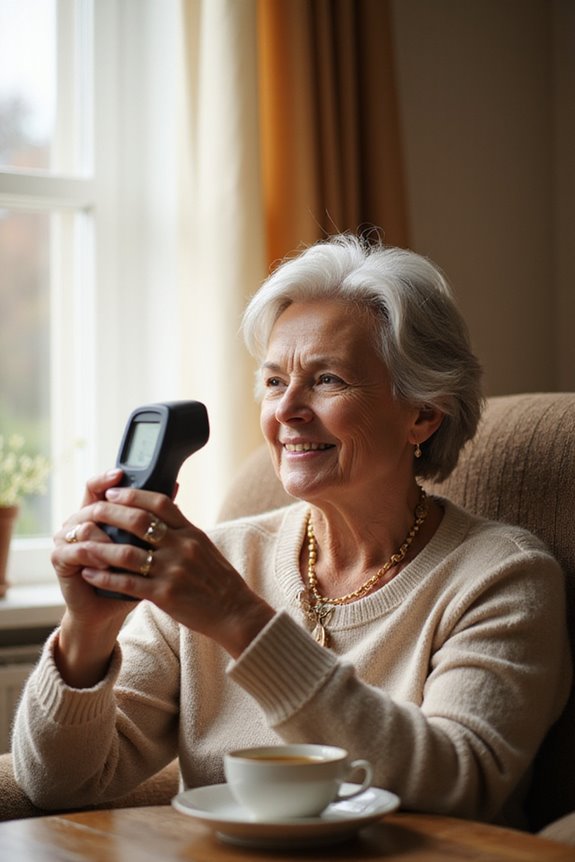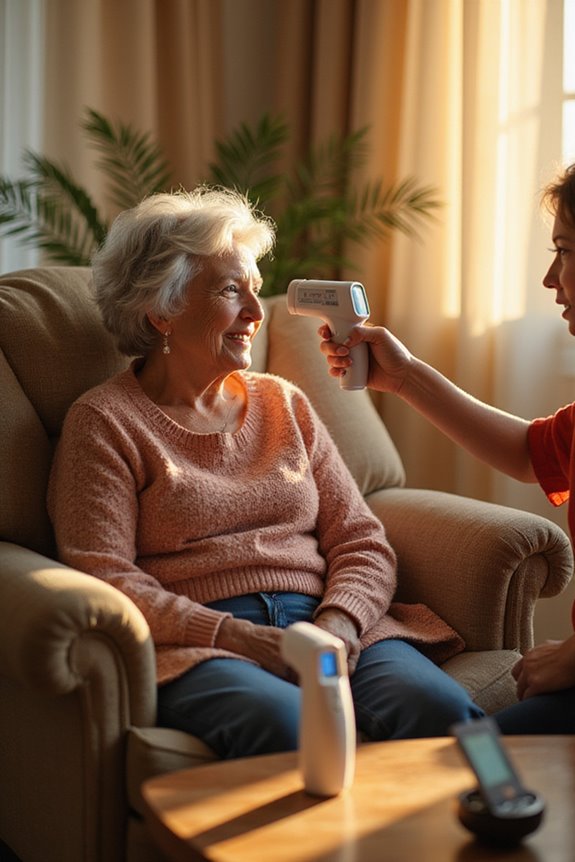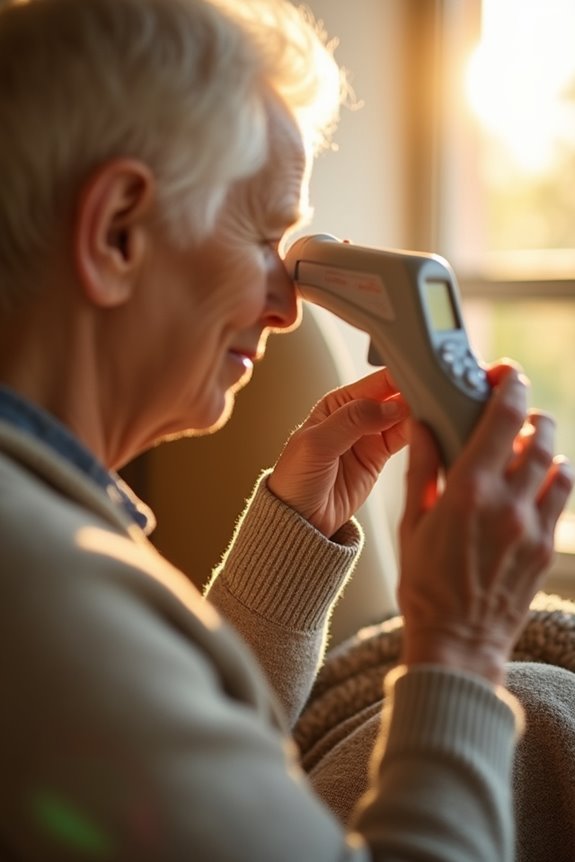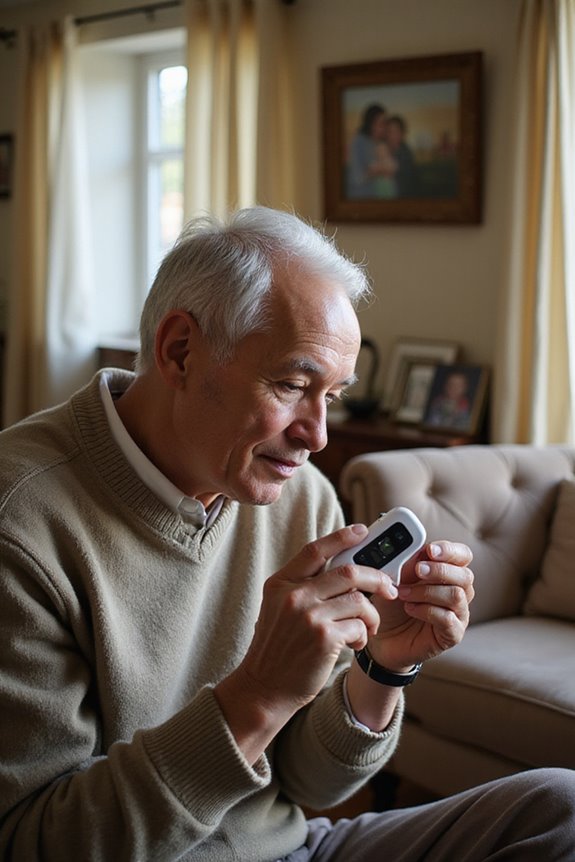To use a contactless infrared thermometer, first acclimatize the device for 15 minutes. Confirm the lens is clean and unobstructed. Aim the thermometer at the intended surface at a 90° angle, maintaining a proper distance for accuracy. Avoid reflective surfaces and control environmental factors, such as humidity and sunlight. Regularly calibrate the thermometer and adjust emissivity settings based on the material being measured. Following these guidelines will confirm reliable temperature readings, and further details will enhance accuracy.
Key Takeaways
- Allow the infrared thermometer to acclimate to the ambient temperature for at least 15 minutes before taking measurements.
- Ensure the lens is clean and unobstructed to obtain accurate temperature readings.
- Aim the thermometer at the target surface at a 90° angle for optimal accuracy.
- Maintain a proper distance from the surface, as specified by the manufacturer, for effective measurement.
- Regularly calibrate the thermometer and adjust emissivity settings for various materials to enhance accuracy.
Understanding the Basics of Infrared Thermometers
Infrared thermometers represent a significant advancement in temperature measurement technology. These devices operate on the principle of black body radiation, where all objects emit infrared radiation proportional to their temperature.
Key Components:
- A lens system focuses infrared radiation onto a thermopile, which consists of multiple thermocouples.
- The thermopile absorbs infrared radiation, converting it to heat energy, which generates an electrical voltage proportional to temperature.
Measurement Process:
- Infrared radiation is focused onto the thermopile, resulting in an immediate transfer of energy.
- This energy generates a voltage output that is converted into a temperature reading, displayed digitally.
Applications:
– Infrared thermometers are widely used in medical, industrial, and environmental contexts, allowing for safe, non-contact temperature measurements.
Preparing for Measurement
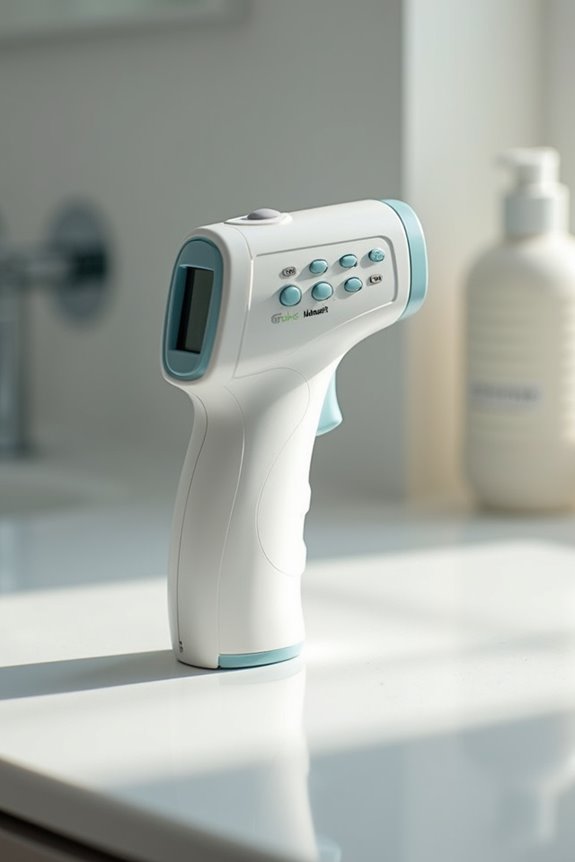
Preparing for measurement requires careful attention to several critical factors that can influence the accuracy and reliability of infrared thermometer readings.
Device Acclimatization
- Allow the device to stabilize at ambient temperature for approximately 15 minutes if moved from a different environment.
- Avoid immediate use after shifting from extreme temperatures to prevent inaccurate readings.
- Maintain consistent storage conditions to minimize acclimatization needs.
Lens Preparation
- Verify the infrared sensor lens is clean and unobstructed.
- Use manufacturer-approved cleaning agents only, avoiding excessive wiping that may damage the lens.
- Inspect the lens for dust or smudges that can interfere with readings. Additionally, ensure that the thermometer is used within its temperature range to guarantee optimal performance.
Properly Aiming the Thermometer
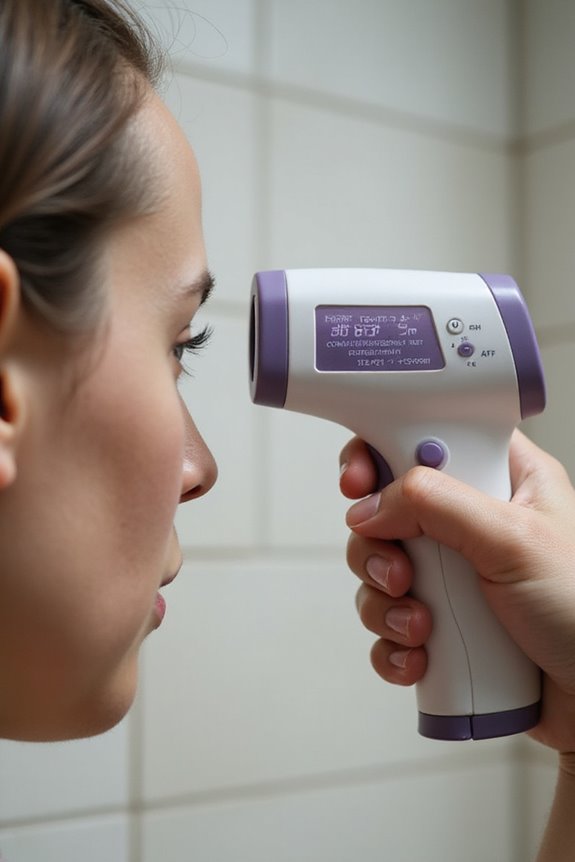
Aiming the thermometer accurately is essential for obtaining reliable temperature readings. Proper alignment involves targeting the center of the forehead while avoiding hairy, sweaty, or dirty areas that can skew results.
- Utilize the thermometer’s laser assistance as a rough guide, guaranteeing the measurement spot fully covers the designated area.
- Be aware of the distance-to-spot (D:S) ratio; for example, a 10:1 ratio allows a 1-inch spot from 10 inches away.
- Maintain a steady hold and avoid obstructions that can deflect infrared radiation.
- Ensure a clear line of sight and keep the environment free from drafts to minimize external influences.
These practices enhance accuracy and guarantee dependable results with the infrared thermometer.
Taking Accurate Temperature Readings
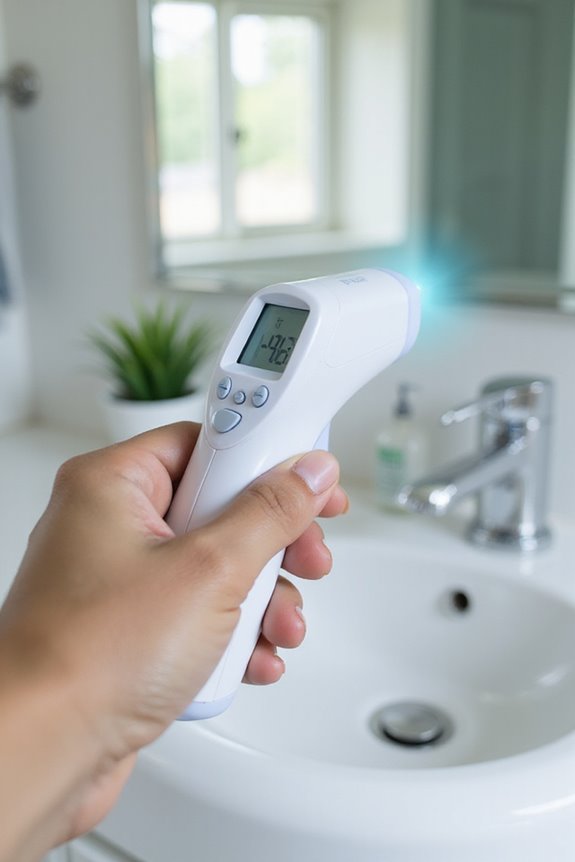
Taking accurate temperature readings requires meticulous attention to detail and adherence to established protocols.
Calibration Frequency
Regular calibration checks are recommended to guarantee medical accuracy. While calibration frequency is not always specified, using calibration tools can verify factory settings throughout the device’s lifespan.
Environmental Factors
Ambient conditions greatly influence reading accuracy. To obtain reliable results:
- Control background thermal radiation; measure in stable environments.
- Avoid humidity variations, sunlight exposure, and drafts.
- Confirm the forehead surface is clean and dry, free of sweat or makeup.
- Have subjects at rest prior to measurement, as thermalized individuals can yield skewed data.
Adjusting for Emissivity Settings
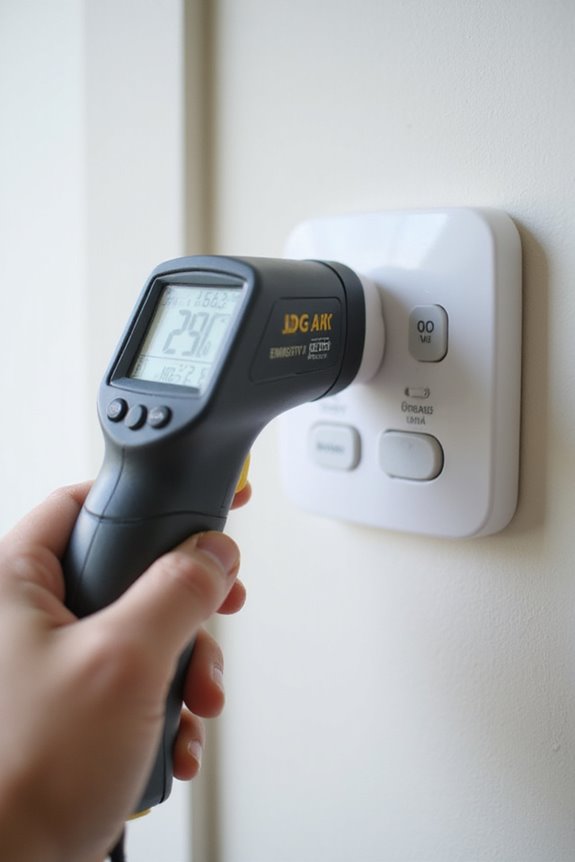
Adjusting emissivity settings is vital for accurate temperature measurements when using contactless infrared thermometers. Emissivity adjustment techniques enable users to compensate for variations in material emissivity values, which can notably affect readings.
- Many organic surfaces default to an emissivity of 0.95; polished metals, however, may range from 0.1 to 0.3.
- Users should consult emissivity charts to determine appropriate values for specific materials before usage.
- Adjustable sensors may feature rotary switches, buttons, or software interfaces for emissivity setting.
- Calibration is essential; using a surface probe thermometer can enhance accuracy.
- Regular checks can help maintain measurement integrity, especially across diverse materials.
Interpreting Temperature Results
Interpreting temperature results from a contactless infrared thermometer requires a clear understanding of how these devices function and the factors influencing their readings.
Understanding Readings
- Infrared thermometers measure surface temperature, reflecting skin temperature rather than core body temperature.
- Normal forehead temperature ranges from 33-35°C (91.4-95°F).
- “Lo” readings may indicate cold skin or environmental influences.
- “Hi” alarms suggest potential fever; thresholds are typically above 37.5°C (99.5°F).
- It’s important to note that infrared thermometers are not suitable for measuring human body temperatures in all situations, as they primarily measure surface temperatures.
Factors Influencing Results
- Temperature variance can be affected by emissivity, distance-to-spot ratio, and environmental conditions.
- Maintaining reading consistency is essential; hold the device steady for 1-3 seconds.
Maintaining Your Infrared Thermometer
Maintaining an infrared thermometer is essential for ensuring accurate and reliable measurements. Regular lens cleaning is vital; use compressed air to remove dust and debris, and gently wipe the lens with a damp cotton cloth if necessary. Avoid solvent-based cleaners to protect the lens surface.
For thermometer storage, keep the device in a protective case, away from moisture and extreme temperatures. After each use, clean the body with a damp cloth and mild soap, avoiding submersion in water. Establish a routine cleaning schedule, ideally every six months, or more frequently in dusty environments. Regularly inspect for damage or dirt buildup, and document calibration dates to guarantee ongoing reliability and performance.
Safety Precautions During Use
Safety precautions during the use of a contactless infrared thermometer are critical for guaranteeing accurate measurements and protecting both the user and the subject.
Laser Beam Precautions
- Avoid aiming the laser beam at anyone’s eyes to prevent injury.
- Be mindful of reflections from shiny surfaces that could redirect the beam.
- Confirm the device is positioned near the forehead before activation.
Device Safety Guidelines
- Maintain a 90° angle to the measurement surface for accuracy.
- Keep the area clean and free of obstructions like hair.
- Avoid measuring through glass or shiny surfaces.
- Allow the thermometer to acclimate to the environment for maximum performance.
- Regularly clean the sensor lens to maintain reliability.
Adhering to these guidelines enhances both safety and accuracy.
Practical Applications in Various Settings
Contactless infrared thermometers have become essential tools across various industries, providing rapid and accurate temperature assessments without physical contact.
Healthcare Applications
- Monitor patient body temperature swiftly, minimizing infection risks.
- Detect inflammation and circulatory issues by visualizing heat patterns on skin.
- Verify sterilization processes to guarantee equipment reaches pathogen-eliminating temperatures.
Food Safety
- Conduct non-contact checks during cooking to prevent bacterial growth.
- Monitor critical temperatures in food processing and storage for quality control.
Industrial Monitoring
– Measure temperatures of materials to maintain production quality and optimize processes.
HVAC Maintenance
– Perform quick surveys of components to detect overheating and guarantee safety.
Building Inspections
– Conduct non-contact checks of surfaces to diagnose insulation issues.
Public Safety
– Screen body temperatures in public spaces during health crises.
Frequently Asked Questions
Can I Use the Thermometer Outdoors in Direct Sunlight?
Using a thermometer outdoors in direct sunlight poses challenges due to sunlight effects, which can lead to inaccurate readings. For reliable results, it’s advisable to measure in shaded areas to mitigate environmental influences on accuracy.
How Do I Store the Thermometer When Not in Use?
To guarantee safe storage, the thermometer should be kept in a protective case, away from extreme temperatures, humidity, and direct sunlight. Proper thermometer care includes cleaning before storage and periodic inspections for any damage or moisture.
What Is the Lifespan of a Contactless Infrared Thermometer?
The lifespan of a contactless infrared thermometer varies based on factors such as handling, calibration frequency, and environmental conditions. Proper maintenance and storage can greatly extend its functional life beyond initial expectations.
Are There Any Specific Brands Recommended for Accuracy?
In the accuracy comparison of thermometers, brand reviews highlight HoMedics, Braun, iHealth, Withings, and Omron. These brands consistently receive praise for their reliable readings, making them popular choices among consumers seeking dependable temperature measurement solutions.
Can I Use It for Measuring Liquid Temperatures?
Ironically, while infrared thermometers promise quick liquid temperature readings, measurement accuracy falters due to surface emissivity variations. Users seeking precision might find themselves longing for deeper insights beneath the surface, where true temperatures remain elusive.

